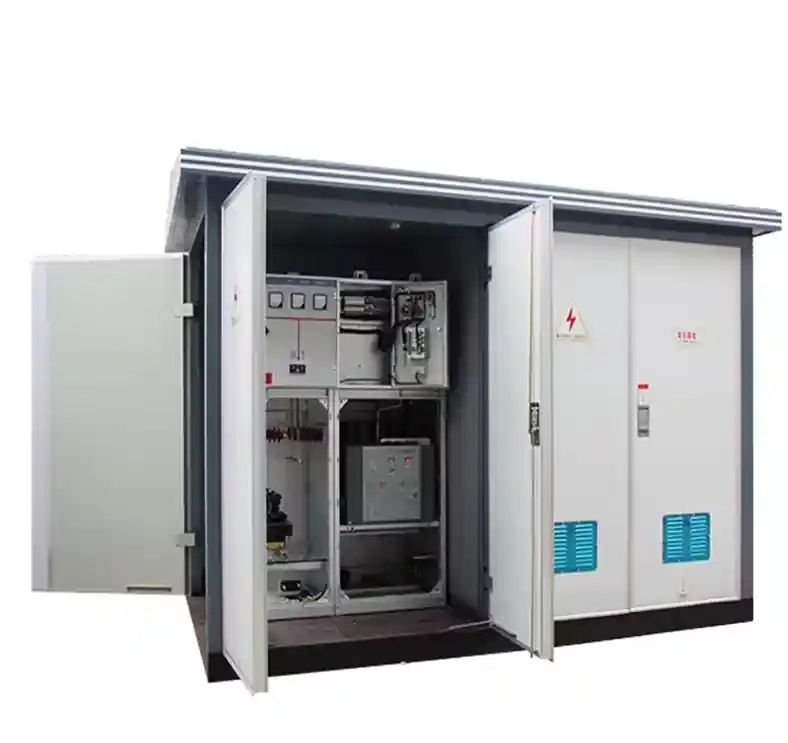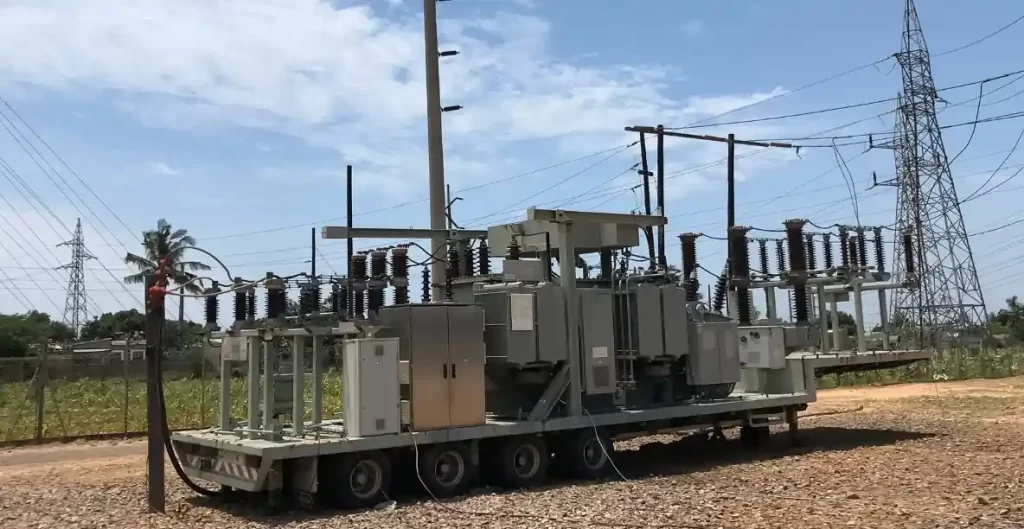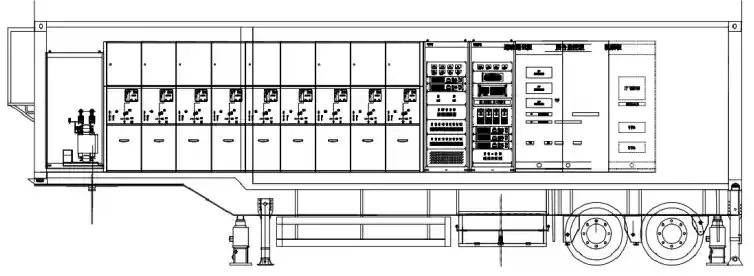In der Welt der elektrischen Energieverteilung, temporäre Umspannwerke spielen eine entscheidende Rolle bei der Aufrechterhaltung der Netzstabilität, bei der Unterstützung der Kontinuität von Projekten und bei der Gewährleistung eines unterbrechungsfreien Dienstes bei Ausfällen oder Übergängen. Ob in Notfallsituationen, bei größeren Bauarbeiten oder als Überbrückung bei permanenten Infrastruktur-Upgrades - diese Umspannwerke sind für einen schnellen Einsatz, Flexibilität und Leistung unter dynamischen Bedingungen ausgelegt.
Was ist eine temporäre Unterstation?
A vorübergehend Umspannwerk ist eine mobile oder semi-permanente Stromversorgungseinrichtung, die die gleichen grundlegenden Funktionen wie ein festes Umspannwerk erfüllt - sie wandelt die Spannung um, ermöglicht das Schalten und gewährleistet den Schutz elektrischer Systeme. Im Gegensatz zu festen Umspannwerken sind temporäre Umspannwerke jedoch Vorgefertigte, modularund konzipiert für schnelle Bereitstellung und Entfernung.
Sie umfassen in der Regel:
- Mittel- oder Hochspannungsschaltanlagen
- Leistungstransformatoren (z. B. 11kV/33kV bis 400V/230V)
- Schutz- und Kontrollsysteme
- Mobile Gehäuse oder auf Anhänger montierte Plattformen

Anwendungsbereiche von temporären Unterstationen
Temporäre Umspannwerke werden häufig in Szenarien eingesetzt, in denen Agilität, Schnelligkeit und Mobilität entscheidend sind:
- Bauvorhaben: Zur Stromversorgung von großen Gebäuden oder Infrastrukturanlagen
- Instandhaltung der Versorgungsnetze: Notstromversorgung bei der Aufrüstung oder Reparatur von Umspannwerken
- Katastrophenhilfe: Notstromversorgung als Reaktion auf Naturkatastrophen oder Stromausfälle
- Veranstaltungen und Festivals: Vorübergehende Stromversorgung für Veranstaltungsorte im Freien
- Abgelegene Industriestandorte: Bergbau, Ölfelder und mobile Bohrinseln

Markttrends und Hintergrund
Nach den jüngsten Berichten von IEEMA und Globale Einblicke in den Markt für UmspannwerkeDie Nachfrage nach temporären Umspannwerken steigt aufgrund wachsender Investitionen in die Infrastruktur, zunehmender Netzmodernisierungsaktivitäten und der Ausweitung von Projekten im Bereich der erneuerbaren Energien stark an.
Die IEEE erkennt auch mobile Leitfaden für elektrische Unterstationen als wesentlicher Bestandteil von Katastrophenresistente Strominfrastruktur-insbesondere in Regionen, die für extreme Wetterereignisse anfällig sind. Führende Hersteller wie ABB, Schneider Elektrischund Siemens entwickeln kompakte, intelligente Lösungen mit Funktionen wie Fernüberwachung, IoT-basierte Diagnostikund SCADA-Integration.
Weitere technische Definitionen finden Sie unter Wikipedia - Elektrisches Umspannwerk.
Technische Daten
Eine temporäre Standard-Umspannstation kann je nach Spannungsebene und Kapazitätsbedarf individuell angepasst werden. Nachstehend finden Sie eine typische Konfiguration:
| Komponente | Beispiel für eine Spezifikation |
|---|---|
| Nennspannung | 11kV / 22kV / 33kV primär |
| Transformator Kapazität | 500 kVA - 5 MVA |
| Sekundäre Spannung | 400V / 230V |
| Mobilität | Auf Anhänger montiert oder im Container |
| Kühlsystem | ONAN oder ONAF |
| Gehäusetyp | IP54-IP65, für den Außeneinsatz geeignet |
| Normen | IEC 60076, IEC 62271, IEEE C57 |

Vergleich: Temporäre vs. permanente Umspannwerke
| Aspekt | Temporäre Unterstation | Ständige Unterstation |
|---|---|---|
| Bereitstellungszeit | Tage bis Wochen | Monate bis Jahre |
| Kosten | Geringere Vorauszahlung; Mietoptionen | Höhere Kapitalinvestitionen |
| Flexibilität | Hoch (verlegbar) | Fester Standort |
| Dauer des Dienstes | Kurz- bis mittelfristige Nutzung | Langfristige Infrastruktur |
| Wartung | Geringere Komplexität | Robustere Systeme |
Temporäre Umspannwerke sind zwar nicht für einen langfristigen Betrieb ausgelegt, werden aber häufig während der Inbetriebnahme- oder Renovierungsphase großer Energieprojekte eingesetzt.
Tipps zur Auswahl: Die Wahl der richtigen temporären Unterstation
Bei der Auswahl einer temporären Unterstation sollten Sie Folgendes beachten:
- Lastanforderungen: Schätzen Sie die Strom- und Spitzenlast, um die Transformatorleistung zu ermitteln.
- Mobilitätsbedürfnisse: Die Anhängermontage ist ideal für häufige Umzüge.
- Umweltbedingungen: Stellen Sie sicher, dass das Gerät Staub, Feuchtigkeit und extremen Temperaturen standhält.
- Grid-Kompatibilität: Anpassung der Eingangs-/Ausgangsspannung und der Schutzsysteme an das örtliche Netz.
- Unterstützung von Anbietern: Wählen Sie Lieferanten, die Installation, Inbetriebnahme und technische Unterstützung vor Ort anbieten.
Renommierte Marken wie PINEELE, ABBund Eaton bieten Miet- und schlüsselfertige Lösungen mit voller Übereinstimmung mit IEC und IEEE Normen.
Autoritative Referenzen
- IEEE Std C37™ Reihe: Schutz und Steuerung für Umspannwerke
- IEC 62271-202: Vorgefertigte HV/LV-Umspannwerke
- ABB Weißbuch: Mobile Umspannwerke für Notstrom und temporäre Stromversorgung
- Wikipedia - Typen von Umspannwerken
Diese Referenzen bieten die technische Validierung und den Hintergrund, den Infrastrukturingenieure und Beschaffungsteams benötigen.
FAQs
A: Je nach Standortbedingungen kann ein temporäres Umspannwerk innerhalb von 3-10 Tagen installiert und in Betrieb genommen werden, während permanente Lösungen Monate dauern.
A: Ja. Bei der Gestaltung nach IEC oder IEEE Sie verfügen über geerdete Gehäuse, Lichtbogenschutz und automatische Auslösemechanismen.
A: Sie sind zwar nicht für den Dauereinsatz konzipiert, aber einige modulare Einheiten können mit zusätzlicher technischer Unterstützung aufgerüstet oder in dauerhafte Einrichtungen integriert werden.
A vorübergehend Leitfaden für Unterstationen ist eine vielseitige, schnell einsatzbereite Lösung, die sich ideal für kurz- bis mittelfristige Stromverteilungsanforderungen eignet. Ganz gleich, ob Sie mit einer Naturkatastrophe konfrontiert sind, Ihre Anlage aufrüsten oder einen abgelegenen Industriestandort mit Strom versorgen müssen, diese Art von Unterstation bietet Zuverlässigkeit, Skalierbarkeitund Compliance mit globalen Standards.


